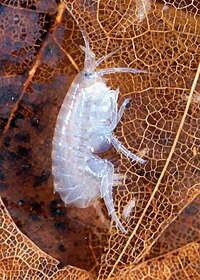
Bioconcentration, metabolism and spatial distribution of 14 C-labelled laurate in the freshwater amphipod Hyalella Azteca.
Sign Up to like & getrecommendations! Published in 2019 at "Environmental toxicology and chemistry"
DOI: 10.1002/etc.4623
Abstract: regulatory assessment of the bioaccumulation from water is commonly based on bioconcentration factors (BCF) derived from fish flow-through tests. Such experiments require many laboratory animals and are time-consuming and costly. An alternative test set-up for… read more here.
Keywords: hyalella azteca; bioconcentration; amphipod hyalella; laurate ... See more keywords

Is Hyalella azteca a Suitable Model Leaf-Shredding Benthic Crustacean for Testing the Toxicity of Sediment-Associated Metals in Europe?
Sign Up to like & getrecommendations! Published in 2019 at "Bulletin of Environmental Contamination and Toxicology"
DOI: 10.1007/s00128-019-02557-6
Abstract: The leaf-shredding crustacean Hyalella azteca, which is indigenous to Northern and Central America, is used to assess environmental risks associated with (metal-)contaminated sediments and to propose sediment quality standards also in Europe. Yet, it is… read more here.
Keywords: hyalella azteca; toxicity sediment; leaf; azteca suitable ... See more keywords

Effect of temperature, food quality and quantity on the feeding behavior of Simocephalus mixtus and Hyalella azteca: implications for biomanipulation
Sign Up to like & getrecommendations! Published in 2019 at "Wetlands Ecology and Management"
DOI: 10.1007/s11273-019-09664-5
Abstract: Increasing temperatures in aquatic ecosystems have resulted in changes in the proliferation patterns and persistence of cyanobacteria, particularly Microcystis sp.. In temperate lakes, large-sized herbivores such as Daphnia magna are used to control cyanobacterial blooms.… read more here.
Keywords: hyalella azteca; simocephalus mixtus; food; microcystis ... See more keywords

Prediction of a peptidome for the ecotoxicological model Hyalella azteca (Crustacea; Amphipoda) using a de novo assembled transcriptome.
Sign Up to like & getrecommendations! Published in 2018 at "Marine genomics"
DOI: 10.1016/j.margen.2017.12.003
Abstract: Due to its sensitivity to many environmental and anthropogenic stressors, including a wide range of chemical compounds, Hyalella azteca, a freshwater amphipod, has emerged as one of the most commonly used invertebrates for ecotoxicological assessment.Peptidergic… read more here.
Keywords: hormone; hyalella azteca; peptide; model ... See more keywords

NMR-based metabolomics for the environmental assessment of Kaohsiung Harbor sediments exemplified by a marine amphipod (Hyalella azteca).
Sign Up to like & getrecommendations! Published in 2017 at "Marine pollution bulletin"
DOI: 10.1016/j.marpolbul.2017.02.067
Abstract: Inflow of wastewater from upstream causes a large flux of pollutants to enter Kaohsiung Harbor in Taiwan daily. To reveal the ecological risk posed by Kaohsiung Harbor sediments, an ecological metabolomic approach was employed to… read more here.
Keywords: hyalella azteca; harbor sediments; kaohsiung harbor; harbor ... See more keywords

Preference of host distributional pattern of Lagenophrys patina Stokes, 1887 (Ciliophora, Peritrichia, Lagenophryidae) on Mexican Hyalella azteca (Saussure, 1858) (Amphipoda) from two lakes in Mexico
Sign Up to like & getrecommendations! Published in 2017 at "Crustaceana"
DOI: 10.1163/15685403-00003703
Abstract: Two Hyalella azteca (Saussure, 1858) populations were studied to statistically determine if their symbiont Lagenophrys patina Stokes, 1887 preferred to attach to body regions and/or appendages. The distribution pattern of the epibiont was investigated according… read more here.
Keywords: hyalella azteca; pattern; patina; host ... See more keywords